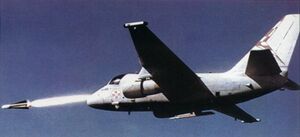Rigoli PM.83 Vichingo
| Rigoli PM.83 Vichingo | |
|---|---|

| |
| Role | maritime patrol aircraft, aerial refueling |
| National origin | |
| Manufacturer | Licanan Defense Industries Rigoli |
| First flight | March 4, 1982 |
| Introduction | December 11, 1983 |
| Status | In service |
| Primary user | Lumenic Armada |
The Rigoli PM.83 Vichingo is a four crew, twin engine maritime patrol aircraft aircraft primarily utilized for anti-submarine warfare in use by the Lumenic Armada since its introduction in 1983. A licensed produced copy of the Licanan Defense Industries S-13, a carrier-based antisubmarine aircraft, the PM.83 Vichingo has evolved to fulfil several roles for both the Lumenic Armada and Lumenic Air Force, including that of a aerial refueling aircraft, electronic signals intelligence gathering platform, airborne ground surveillance and battle management asset. Due to the aircraft distinctive engine noise, it is often referred to as Vento che Sussurra, or "The Whispering Wind"
The Lumenic Armada initially purchased a total of 120 S-13 aircraft from the Republic of Licana in 1979 for use in securing sea lanes between Luminerra and other ports in Omand and The Republic of Licana in Ordia. The aircraft provided to be a reliable workhouse for the Lumenic Armada, and soon spawned several mission-specific variants, including an electronic intelligence platform and aerial refueling aircraft, and a battlefield control and observation platform. Updates to the avionics, sensors and weapons system have kept the platform viable throughout the 2000's and into the modern day, with the aircraft expected to remain in service with both the Lumenic Armada and Lumenic Air Force well into the 2030s.
History and development
During the Omandan Continental War, the Republic of Licana provided aid to the allied nations fighting against the Order of Soviet Socialist Republics, firstly in material assets, followed by direct intervention in July of 1972. The bulk of material assets and military personnel involved were transshipped across the Theatian Ocean and were frequently targeted by the Soviet Navy, suffering losses to submarines and surface fleet elements, as well as from long range strike aircraft, such as the Voloshin Vo-22M maritime strike aircraft. To that end, the Lumenic Armada desired a versatile maritime patrol aircraft to assist in securing vital shipping lanes between itself and Ordia. In 1975, following the Soviet withdrawal from Luminerra, the government of Luminerra approached the Republic of Licana with an interest in evaluating the S-13 aircraft. Despite the lack of need for a carrier based platform, the Lumenic Armada was impressed by the aircraft's abilities, and envisioned adapting the type to fill several roles, as the Licanan Navy had done. This was something that was considered not feasible with other land based aircraft such as the Trinovantanske Luftfartssystemer FSj-23 aircraft.
Rigoli approached Licanan Defense Industries in 1981 requesting the right to produce its own variant of the aircraft, both to replace combat losses as well as to capitalize on the versatility of the aircraft to fulfill multiple roles within the Lumenic Armada. Technical assistance from LDI assisted Rigoli in setting up production within 12 months, and the first Rigoli PM.83, designated X-1 Il Vichingo flew in March of 1982, with the first production aircraft completed in August of 1983. Accept into service as the PM.83 Vichingo in December of that same year, it was immediately deployed to active duty squadrons to assist with the monumental task of keeping sea transit between southern Omand and Ordia viable.
Following the successful deployment of the PM.83, Rigoli embarked on the second phase of development of the aircraft. Taking cues from sucsessfulmodfiacations preformed by the Licanan Navy, resulting in several mission-specific variants, including an electronic intelligence platform and aerial refueling aircraft. Further develops lead to more innovative and comprehensively different versions of the aircraft, including a battlefield control and observation platform.
Operational history
Variants
Specifications (PM.83C)
General characteristics
- Crew: 4
- Length: 53 ft 4 in (16.26 m)
- Wingspan: 68 ft 8 in (20.93 m)
- Width: 29 ft 6 in (8.99 m) folded
- Height: 22 ft 9 in (6.93 m)
- Height tail folded: 15 ft 3 in (5 m)
- Wing area: 598 sq ft (55.6 m2)
- Aspect ratio: 7.73
- Empty weight: 26,581 lb (12,057 kg)
- Gross weight: 38,192 lb (17,324 kg)
- Max takeoff weight: 52,539 lb (23,831 kg)
- Fuel capacity:
- Internal fuel capacity: 1,933 US gal (1,610 imp gal; 7,320 L) of JP-5 fuel
- External fuel capacity: 2 × 300 US gal (250 imp gal; 1,100 L) drop tanks
- Powerplant: 2 × Viccari AE-221 turbofan engines, 9,275 lbf (41.26 kN) thrust each
Performance
- Maximum speed: 429 kn (494 mph; 795 km/h) at sea level
- Maximum speed: Mach 0.79
- Cruise speed: 350 kn (403 mph; 648 km/h)
- Stall speed: 97 kn (112 mph; 180 km/h)
- Range: 2,765 nmi (3,182 mi; 5,121 km)
- Combat range: 460.5 nmi (530 mi; 853 km)
- Ferry range: 3,368 nmi (3,876 mi; 6,238 km)
- Service ceiling: 40,900 ft (12,500 m)
- Rate of climb: 5,120 ft/min (26.0 m/s)
- Wing loading: 68.5 lb/sq ft (334 kg/m2)
- Thrust/weight: 0.353
Armament
- Up to 4,900 lb (2,220 kg) on 4 internal and 2 external hardpoints, including:
- 10 × AAB-227/60 freefall bombs, AAB-220/97 guided bombs, or AAB-220/76A laser-guided bombs
- 2 × AAB-450/60 1000 lbs freefall bombs, AAB-450/97 guided bombs, or AAB-459/76A laser guided bombs
- 2 × AAB-900/60 2000 lbs freefall bombs
- 6 × AAB-72/90 cluster bombs
- 4 × Testa-A torpedos
- 6 × mines or depth charges
- 2 × AAM-75 air to surface missile
- 2 × AAM-18 anti-ship missile
- 1 × AAM-01 air-launched cruise missile
- The underwing hardpoints can also be fitted with unguided rocket pods or fuel tanks.
